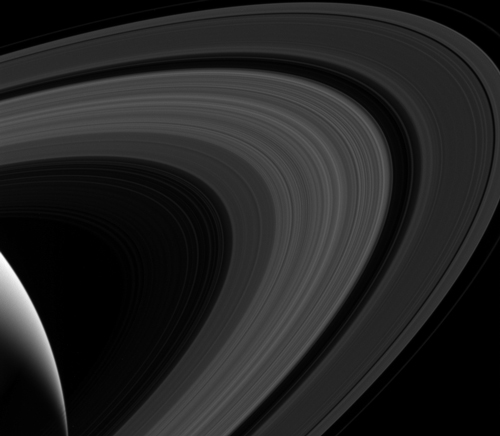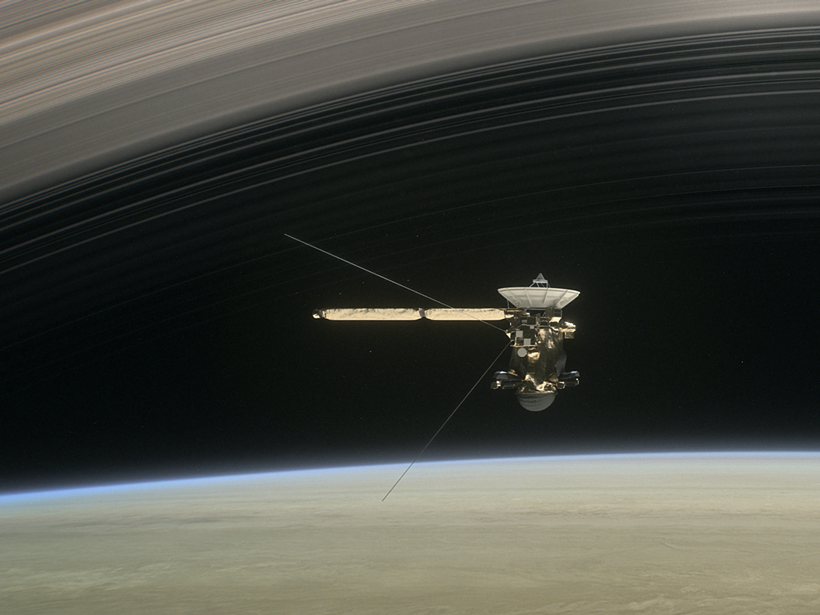After 13 years filled with surprises, paradigm-shifting discoveries, and hundreds of awe-inspiring pictures, NASA’s Cassini-Huygens mission will end soon. On 15 September, the spacecraft will plunge into Saturn’s atmosphere and disintegrate.
It’s “a region where no spacecraft has flown before.”
The last stage of the mission, the so-called “grand finale” orbits, began on 22 April with a gravitational boost from Titan. Since then, Cassini has slowly descended closer and closer to Saturn to explore the space between the rings and the planet itself. It’s “a region where no spacecraft has flown before,” said Linda Spilker, the Cassini-Huygens mission head scientist.
Currently, Cassini is completing grand finale orbit 16 out of the final 22: It takes 6 days to complete an orbit. In these last orbits, the spacecraft has already snapped images from the never-before-seen perspective between the rings and Saturn. In a matter of weeks, it will skim the planet’s atmosphere.
From now until Cassini crashes, its mission will be to start answering some long-standing questions about Saturn itself. Here are three of those questions.
How Old Are Saturn’s Rings?
“If we had been around 4 billion years ago, what would Saturn’s rings have looked like?”
A long-running debate in Saturn science involves the age of the rings: Some researchers think they’re young, about 100 million years old, and some researchers think they could be 4 or 5 billion years old.
“If we had been around 4 billion years ago, what would Saturn’s rings have looked like?” asks Richard French, the team leader of Cassini’s Radio Science Subsystem (RSS), a payload that studies Saturn’s gravitational field. “Would they be similar to what they are now, or would they have evolved over time?”
Voyager and Hubble data suggested that because the rings are bright and seemingly untarnished by interplanetary dust that rains inward from the Kuiper belt, the rings are young. Some estimates give an age of around 100 million years old, said Jeffrey Cuzzi, a planetary scientist on the mission who studies Saturn’s rings. If they were very old, some researchers postulate, the water ice chunks that make up Saturn’s rings would be duller and darker.
However, there’s still a problem with this reasoning, Cuzzi said. Scientists generally agree that the rings probably formed from a catastrophic breakup of a moon. But 100 million years ago, the solar system was less chaotic than in its earlier days. “It’s hard to find a way to destroy a moon” in this more recent environment, he noted.
On Earth 100 million years ago, dinosaurs were thriving—evidence of a relatively calm system (aside from the impact believed to have ended their species). By contrast, between about 3.8 and 4 billion years ago, the adolescent solar system went through the Late Heavy Bombardment, with large objects hurling every which way. Evidence of this chaos is scattered across the solar system in craters.

Those are just two of many arguments trying to explain the rings’ age. One way to rule out some of these arguments is a precise measurement of the rings’ mass, Cuzzi said. Cassini data suggest that the mass would be similar to Saturn’s current moon Mimas. But how much mass would this have been, precisely?
If the rings are light, that could roughly indicate their youth: Debris from a smaller, lighter moon might have dispersed completely if the catastrophic event happened 4 or 5 billion years ago, French said. If the rings are relatively heavy, then evolution models favor ring formation during the Late Heavy Bombardment. “The larger the precursor [moon], the larger the mass of the ring, the harder it is for that ring to evolve over time,” he continued.
That’s where the RSS comes in. Cassini sends radio waves to Earth, which are picked up by NASA’s giant radio antennas around the world. While Cassini is in the gap between Saturn’s rings and Saturn itself, scientists can evaluate how much Cassini gets tugged by the planet’s gravity and by its rings’ gravity. These tugs directly relate to the mass of the rings, which scientists hope to nail down with the final RSS measurements.
How Long Is a Day on Saturn?
Determining the precise rotational period of the gas giant proves difficult because Saturn lacks static features and hosts no classic “surface” to speak of.
It may seem like an easy question to answer, but scientists aren’t sure how long a day lasts on Saturn. Determining the precise rotational period of the gas giant proves difficult because Saturn lacks static features and hosts no classic “surface” to speak of. So scientists cannot decouple the dynamic atmosphere seen in images from whatever may be below it.
But gas giants have magnetic fields, created by internal processes such as rotating electrical fluids, that scientists can track. If a magnetic field is tilted compared with its rotational axis, it’ll cause detectable wobbles. Such is the case for Jupiter. Researchers easily determined its orbital period because of its tilted magnetic field.
Not so with Saturn. Its magnetic field is almost perfectly aligned with its rotational axis, providing no significant wobbles for Cassini to detect from far away. What’s more, the small signal that researchers can detect changes from the north to the south pole, said Michele Dougherty, the principal investigator for Cassini’s magnetometer instrument.
Saturn’s day seems to be between “10.6 and 10.8 hours [long], probably, but the signal we’re seeing, we’re not sure it’s linked to the interior at all,” she said in a press statement.
So far, researchers haven’t found the answer: Cassini data have shown that Saturn’s magnetic field is tilted less than 0.06° from its rotational axis, not a promising tilt to determine the length of a day. Scientists think something deep in Saturn’s atmosphere may be masking the signal from the magnetic field, and they hope that getting even closer to the planet may finally reveal this basic characteristic, Dougherty said.
What’s Going on in Saturn’s Atmosphere?
“Titan surprised many of the atmospheric scientists with a rich set of complex ions in the upper atmosphere.…Will Saturn do the same?”
During the 18th grand finale orbit (or the 288th orbit since the mission’s beginning), between 10 and 17 August, Cassini will, for the first time, skim across the top of Saturn’s atmosphere. In the final five orbits, the spacecraft will collect data on the neutral molecules of the upper atmosphere, such as hydrogen, helium, water, and methane, said Scott Edgington, the Cassini-Huygens’s team deputy project scientist.
The instruments “will also be poised to detect more complex molecules created after molecules such as methane and water are broken up by solar ultraviolet photons and electron impact,” Edgington said.
“Titan surprised many of the atmospheric scientists with a rich set of complex ions in the upper atmosphere, thus causing us to rethink our theories and models of the upper atmosphere,” he continued. “Will Saturn do the same?”
—JoAnna Wendel (@JoAnnaScience), Staff Writer
Citation:
Wendel, J. (2017), A wealth of science to come during Cassini’s final orbits, Eos, 98, https://doi.org/10.1029/2017EO078833. Published on 01 August 2017.
Text © 2017. The authors. CC BY-NC-ND 3.0
Except where otherwise noted, images are subject to copyright. Any reuse without express permission from the copyright owner is prohibited.

